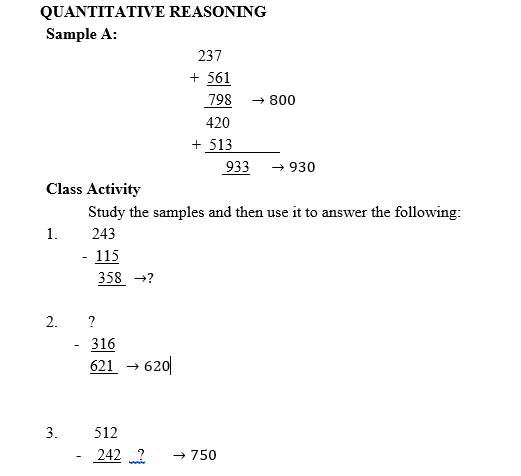To approximate a number means to write a number near the original number that is a number not exactly the original number. It may be a bit more or less than the original. Whole numbers can be approximated to the nearest ten, hundred, thousand, million, etc.
Let’s consider the table below:
| NUMBER | APPROXIMATED |
| 186 | 190 to the nearest ten |
| 1586 | 1600 to the nearest hundred |
| 346 | 300 to the nearest hundred |
| 1481 | 1480 to the nearest ten |
| 687.4 | 687 to the nearest unit |
| 4225 | 4000 to the nearest thousand |
| 69685.42 | 69690 to the nearest ten |
| 2.634 | 2.630 to the nearest thousandth |
| 0.214 | 0.214 to the nearest thousandth |
From the above table, we can see that when numbers are approximated, they do not give the exact result expected. In approximation, we only consider the next figure we are approximating. If it is up to 5 and above, we take it as one (1) and add the (1) to the figure we are approximating to. If it is less than 5, we make it zero (0) and add zero to the figure.
Examples:
Solution:
48 + 226 +592 = 866.
To the nearest hundred 866 = 900
Solution:
To the nearest hundred = 700
Solution:
1.45m + 3.00m + 2.11m = 6.56m.
To the nearest hundredth, 6.56m is the answer.
Note that in the example above, the answer is exactly the as the number approximated, which is 6.56m.
NOTE: Correcting numbers to the nearest ten (10) means leaving your answer with only one zero at the back of your answer (the unit position), while to the nearest hundred (100) and thousand (1000) means leaving two zeros and three zeros at the back respectively
Example:
Write 7822 to the (a) nearest ten (b) nearest hundred (c) thousand
Solutions:
Significant Figures
Numbers could be rounded up to a given significant figures. Significant figures are obtained by counting the number of digits in a given number.
When rounding up or down a number to given significant figures we count the digits of the number from left hand side to the required significant figures, then we consider the next digit to do the rounding up or down. If the digit is less than 5, we round down the number to zero and if it is equal to or greater than 5, we round it to one (1)


Example:
Round off:
Solution:
(ii) 456.36 = 456 (3 s.f)
(ii) 0.03278 = 0.033 (3 s.f)
Class Activity:
Decimal places
The number of digit(s) after the decimal point in any given number is called its Decimal places.
Example:
Correct the following to i) 1 decimal place ii) 2 decimal places iii) 3 decimal places
Solution
0.10775 = 0.1 to 1d.p
0.10775 = 0.11 to 2d.p
0.10775 = 0.108 to 3d.p
0.08017 = 0.1 to 1dp
0.08017 = 0.08 to 2dp
0.08017 = 0.080 to 3dp
2.1359 = 2.1 to 1dp
2.1359 = 2.14 to 2dp
2.1359 = 2.136 to 3dp


Class Activity
Write the following numbers correct to 1, 2 and 3 decimal places


PRACTICE QUESTIONS
ASSIGNMENT
a)0.90907 b) 0.9997 c) 15.09624
Read our disclaimer.
AD: Take Free online baptism course: Preachi.com 